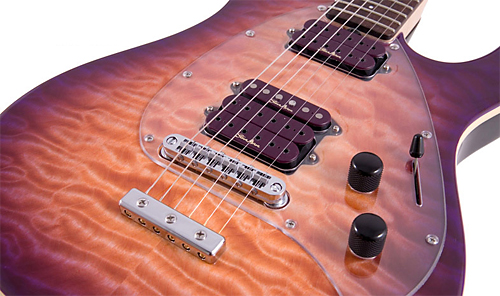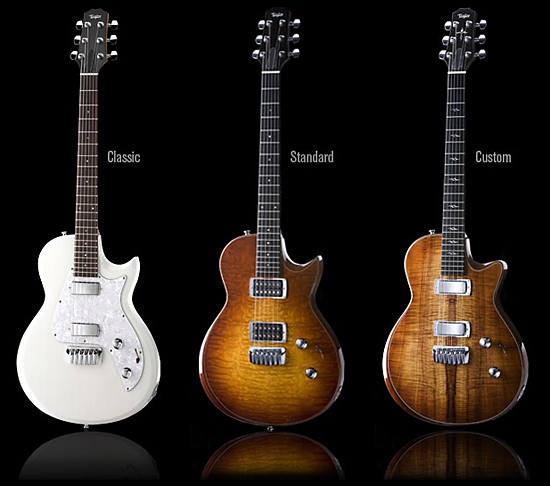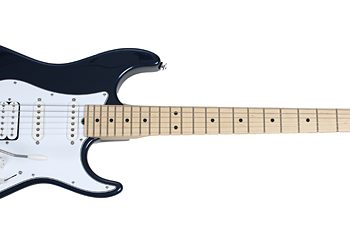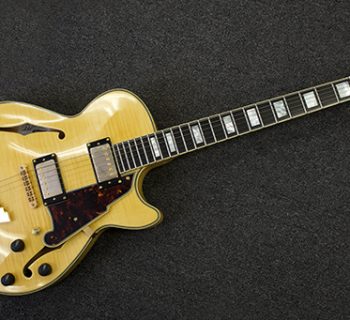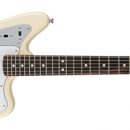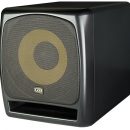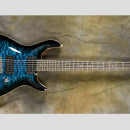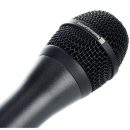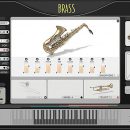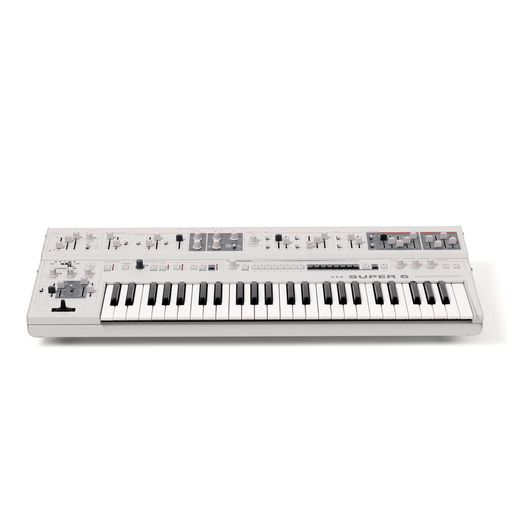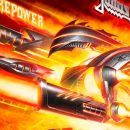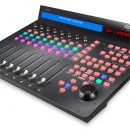Guitars bearing the Team J-Craft stamp are built by Ibanez master luthiers in Japan. While Ibanez doesn’t specifically offer “custom shop” products, these guitars are certainly the best of what they have to offer in an already excellent product line, and the new RGT320Z sits at the top of the RG series.
| Category | Value | Rating |
| Features | 20% | |
| Usability | 25% | |
| Sound | 25% | |
| Documentation & Support | 10% | |
| Price | 20% | |
| OVERALL RATING = 3.3 3.6 stars or better: Outstanding, WIHO Award 3 stars or better: Worth considering 2 stars or better: Suited to specific needs 1 star or less: Not recommended |
||
The beauty of the RGT320Z’s hot red flamed top with racing stripes floored us, and we loved its modern hardware appointments such as the new Edge Zero Bridge with ZPS3 spring system — the finest double-locking tremolo we’ve ever experienced.
The RGT320Z delivered a wide range of tones suited to a broad range of players. Equipped with medium-gain DiMarzio IBZ pickups, this guitar makes a great option for players who typically play less “exciting” looking instruments but who secretly yearn to rock out a little bit. It also features one of the best (if not the best) double-locking tremolo units we’ve ever used.
Our only concern came from the noticeably wide Prestige Wizard fretboard. At first touch, we thought a seven-string neck had been placed on the review guitar by mistake! But once our hands adjusted to this guitar’s different feel (compared to other RG- and S-series instruments), the RGT320Z rewarded us with great sound, superb construction, and style galore.
Features
The RGT320Z we reviewed features a mahogany body with a beautiful, hot red AAA quilted maple top and neck-thru construction. Details in the design include beautiful racing stripe inlays and an a subtle abalone block inlay adorning the top edge of the headstock.
This RG’s five-piece Wizard neck features traditional abalone dot inlays on a rosewood fretboard, Gotoh tuners, jumbo frets, a glossy neck finish, and a 25.5 inch scale, but that’s where the similarity ends when compared with what you might consider typical of RG-series guitars you’ve played before. Unlike the Wizard II neck found on many RG-series guitars, the RGT320Z’s Wizard neck is slightly thinner but significantly wider. The ultra-flat fretboard has a larger radius, too.
| RGT320Z’s Wizard Neck | Ibanez Wizard II Neck | |
| Thickness at first fret | 18 mm | 19 mm |
| Thickness at twelfth fret | 20 mm | 21 mm |
| Width at first fret | 43 mm | 43 mm |
| Width at twenty-fourth fret | 58 mm | 56 mm |
| Fretboard radius | 430 mm | 400 mm |
The RGT320Z has two direct-mounted DiMarzio IBZ RG humbucking pickups and a five-way switch. Although there is no coil tap feature specifically, the second pickup position uses the inside poles of each pickup in combination for a dual single-coil sound. A single tone control affects all pickup selections.
 The Edge Zero Bridge with ZPS3 spring system is the most advanced tremolo to ship on an Ibanez guitar, designed to provide more accurate tuning stability for players who like to bend pitch up or down. The ZPS3 spring system, installed inside the rear of the guitar, pivots around a center fulcrum providing a true return-to-zero after every pitch bend or dive bomb. A thumb wheel on the rear springs, accessible without removing the back plate, enables fine tuning of the system as springs wear, and players familiar with the Hipshot Tremsetter system will be right at home with this more-rugged but comparable system.
The Edge Zero Bridge with ZPS3 spring system is the most advanced tremolo to ship on an Ibanez guitar, designed to provide more accurate tuning stability for players who like to bend pitch up or down. The ZPS3 spring system, installed inside the rear of the guitar, pivots around a center fulcrum providing a true return-to-zero after every pitch bend or dive bomb. A thumb wheel on the rear springs, accessible without removing the back plate, enables fine tuning of the system as springs wear, and players familiar with the Hipshot Tremsetter system will be right at home with this more-rugged but comparable system.
A standard locking nut at the headstock completes the double-locking system, and fine tuners on the bridge enable small adjustments once locked. The new Toplock design at the headstock eliminates the need for a string tree/retainer bar — string run straight to the Gotoh tuners from the redesigned locking nut. Further, the Edge Zero tremolo can be locked for pitch-down operation only.
Our one bewilderment, though, was a thumbscrew on the top surface of the bridge. It didn’t seem to do anything, and wasn’t identified in the documentation. After asking Ibanez about it, we learned that it is an intonation adjustment bolt, similar to the one found in the Edge ZR bridge.
Usability
The RGT320Z takes some getting used to — it’s fascinating to experience what a significant difference just two millimeters of neck width and an increased radius make in the feel of the instrument. Our initial reaction to playing the guitar was that Ibanez took a seven-string guitar neck and slapped it onto a six-stringed instrument!
Although the neck isn’t nearly as wide as what you’ll find on a typical Ibanez seven-string, we think that players who have fallen in love with those guitars, but who sometimes like to play six-string guitars, will flock to this guitar like flies to… um… a guitar that someone spilled some soda on! But for players who are used to the narrower neck found on most Ibanez RG- or S-series instruments, your first reaction (like ours) will be one of great surprise.
That said, once we got past our initial reaction, we were surprised by how quickly our playing style adapted to the wider neck. The string spacing felt petty natural, and the obvious extra space between the high E string and the edge of the fretboard made it easier to apply extreme vibrato on this string without the risk of pulling the string past the edge of the fretboard as can sometimes happen on guitars with extremely narrow neck profiles.
The new Edge Zero Bridge with ZPS3 spring system is a work of beauty and a marvel of excellence, but it evoked mixed emotions from us since it delivers a grand case of two steps forward and one step back. On the positive side, the bridge continues Ibanez’s tradition of providing Floyd Rose-style tremolo units that are flush with the guitar body, and tuning stability remains at the top of the heap when it comes to floating tremolo units. We’ve gone weeks without retuning Ibanez guitars with Edge-series tremolos, and the RGT320Z is yet another guitar that you can rely on to stay in tune throughout your crazy antics with a whammy bar.
The ZPS3 spring system works great. Throughout a wide range of string bending, the bridge remained almost perfectly fixed. On traditional floating tremolo units, the bridge typically moves slightly with a string bend, resulting in slightly imperfect pitch for other non-bent notes that are sustained. Thanks to the fulcrum installed in the rear cavity, this shouldn’t be of any concern to players wary of floating tremolo systems.
Bending the tremolo up or down always returned to a perfect zero position, and a thumb wheel on the rear makes it easy to adjust the counter-balance as the main springs loosen over time (though we had no need to make adjustments on our review instrument). A tension collar surrounding the snap-in tremolo arm enabled us to adjust whether or not the arm stayed in place where we positioned it or hung freely when released.
Years ago we used to install Hipshot Tremsetters inside Floyd Rose- and Kahler-equipped guitars, but periodically, you had to remove the guitars’ rear plate in order to make adjustments to the counter-balance via a screwdriver. Ibanez took that product’s great concept and implemented it superbly.
 That one step backwards we mentioned? You have to cut the balls off of the strings in order to use them. We were thrilled with the Edge Pro II tremolo (found on other Ibanez guitars) that didn’t require this tedious extra step, but this annoyance is greatly outweighed by the advantages of this new system.
That one step backwards we mentioned? You have to cut the balls off of the strings in order to use them. We were thrilled with the Edge Pro II tremolo (found on other Ibanez guitars) that didn’t require this tedious extra step, but this annoyance is greatly outweighed by the advantages of this new system.
The mahogany body is on the heavier side, approaching nine pounds, but wasn’t as heavy as some other similarly-built guitars we’ve played. The instrument is well balanced whether standing or seated, and with the neck-thru construction, we loved how seamlessly the neck joined the body.
And let’s not overlook one other nice little detail — a holder for your Allen wrenches located behind the headstock!
Sound
When it comes to tone, the Ibanez RGT320Z is something of a sheep dressed in wolf’s clothing. While the RG series is commonly found in hard rock and heavy metal settings (where this guitar would certainly be quite happy), the medium-gain DiMarzio IBZ ceramic pickups don’t push the depths of heaviness like you may expect.
Although right at home in a hard rock situation, this guitar is useful in a much broader range of musical settings. From classic rock to wedding bands to country to blues, if you’ve wanted to break away from the typical strat-type guitar in favor of something with a little more aggressive flair, the RGT320Z would be a great guitar to check out.
The DiMarzio IBZ pickups generated an extremely wide range of tones across its five pickup positions. Besides the neck- and bridge-only positions, other settings include selecting just the inside poles from both pickups, both humbuckers together, and the neck pickup wired in parallel. We were particularly impressed by both the range of different tones generated, but also by the evenness of volume across each position. As a result, we actually found ourselves playing with more in-between pickup positions than usual on this guitar.
The pickups are direct mounted to the body. Between that and the neck-thru construction, the guitar delivered excellent sustain and rich tone. Through our Mesa/Boogie Dual Rectifier Road King II, the RGT320Z was well suited to general-purpose hard rock styles of play, but we weren’t able to generate the kind of extremely saturated high-gain tone that some modern metal calls for. For bluesy playing, we enjoyed smooth tones from the neck pickup.
Through our Fender Super-Sonic’s clean Bassman and Vibrolux voicings, we were able to generate some very strat-like jangly tones from the second switch position (inside poles from each pickup, effectively delivering single-coil tone). Playing the bridge pickup through this amp, the DiMarzio IBZ pickup had just enough gain to slightly break up the signal, delivering vintage rock tones.
The pickups did a fine job of providing clear separation of notes when playing through high-gain distortion — something we’re always especially picky about given our love of progressive rock and complex chord voicings. Note that body wood and mounting technique greatly influence the sound of pickups. On some other Ibanez guitars with these pickups, we hadn’t been as impressed by the tone, but we were quite pleased in this case. Players seeking wild harmonics will have to work a bit harder to generate them with this guitar, though. We tend to find more easily excitable harmonics from ring-mounted pickups, and pickups with slightly more gain.
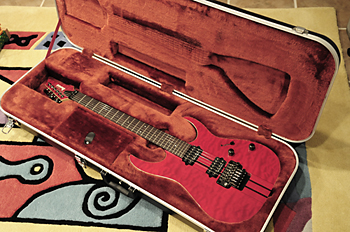 Documentation and Product Support
Documentation and Product Support
We were excited to find a bound book inside the RGT320Z’s molded guitar case, but after taking into account the numerous languages contained within, it turned out that the information about the guitar was useful, though not as comprehensive as we had looked forward to.
Controls related to guitar function were covered in depth, including making adjustments to various tremolo systems, neck intonation, etc. But as the manual is generic and applies to numerous guitar configurations, you have to know specifically which bridge your guitar is equipped with… and the Edge Zero bridge isn’t in the documentation yet! Fortunately, it’s very similar to the Edge ZR bridge.
Further, the pickup configuration was not described in the documentation at all. We had to refer to a diagram in the back of the Ibanez 2008 product catalog (a downloadable PDF from the Ibanez.com website) in order to learn how the five-way pickup selector was wired.
Price
The RGT320Z (MSRP $2,999) retails for just under $2,300 with a Team J-Craft molded case, making it one of the most expensive guitars in the Ibanez product line. We suspect that most of the reason for this high cost is due to the elaborate woodwork with racing stripes running through the beautiful flamed top and subtle details like the abalone inlay on the headstock.
That said, the RGT320Z is an extremely well made, quality instrument that sounds great in a variety of playing situations and is priced comparably to other high-end instruments.
Contact Information
Ibanez
www.ibanez.com
| Evaluation Short-List |
|


